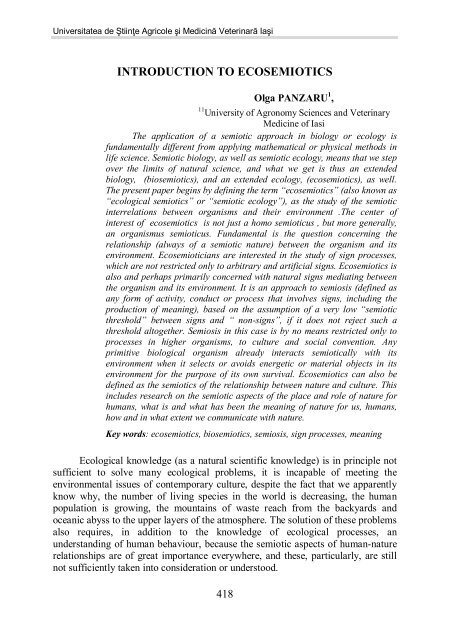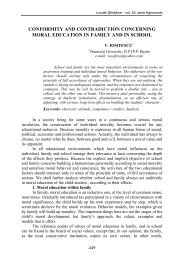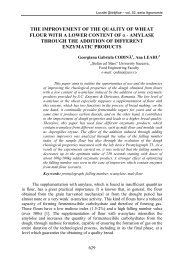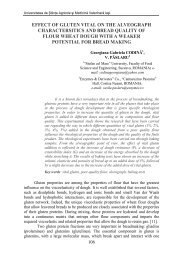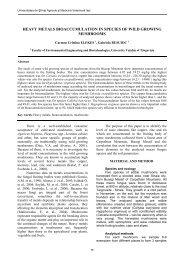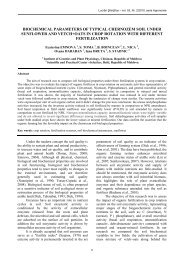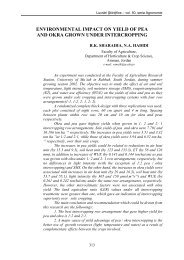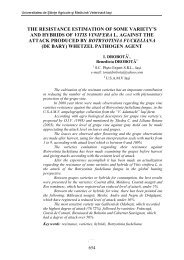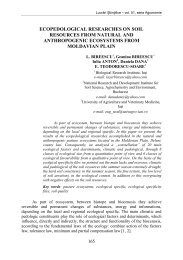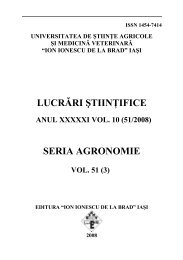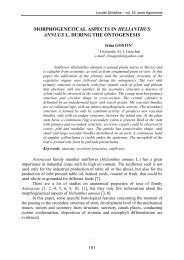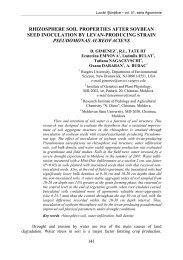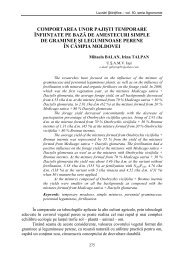introduction to ecosemiotics - LucrÄri ÅtiinÅ£ifice. Seria Agronomie
introduction to ecosemiotics - LucrÄri ÅtiinÅ£ifice. Seria Agronomie
introduction to ecosemiotics - LucrÄri ÅtiinÅ£ifice. Seria Agronomie
Create successful ePaper yourself
Turn your PDF publications into a flip-book with our unique Google optimized e-Paper software.
Universitatea de Ştiinţe Agricole şi Medicină Veterinară Iaşi<br />
INTRODUCTION TO ECOSEMIOTICS<br />
418<br />
Olga PANZARU 1 ,<br />
11 University of Agronomy Sciences and Veterinary<br />
Medicine of Iasi<br />
The application of a semiotic approach in biology or ecology is<br />
fundamentally different from applying mathematical or physical methods in<br />
life science. Semiotic biology, as well as semiotic ecology, means that we step<br />
over the limits of natural science, and what we get is thus an extended<br />
biology, (biosemiotics), and an extended ecology, (<strong>ecosemiotics</strong>), as well.<br />
The present paper begins by defining the term “<strong>ecosemiotics</strong>” (also known as<br />
“ecological semiotics” or “semiotic ecology”), as the study of the semiotic<br />
interrelations between organisms and their environment .The center of<br />
interest of <strong>ecosemiotics</strong> is not just a homo semioticus , but more generally,<br />
an organismus semioticus. Fundamental is the question concerning the<br />
relationship (always of a semiotic nature) between the organism and its<br />
environment. Ecosemioticians are interested in the study of sign processes,<br />
which are not restricted only <strong>to</strong> arbitrary and artificial signs. Ecosemiotics is<br />
also and perhaps primarily concerned with natural signs mediating between<br />
the organism and its environment. It is an approach <strong>to</strong> semiosis (defined as<br />
any form of activity, conduct or process that involves signs, including the<br />
production of meaning), based on the assumption of a very low “semiotic<br />
threshold” between signs and “ non-signs”, if it does not reject such a<br />
threshold al<strong>to</strong>gether. Semiosis in this case is by no means restricted only <strong>to</strong><br />
processes in higher organisms, <strong>to</strong> culture and social convention. Any<br />
primitive biological organism already interacts semiotically with its<br />
environment when it selects or avoids energetic or material objects in its<br />
environment for the purpose of its own survival. Ecosemiotics can also be<br />
defined as the semiotics of the relationship between nature and culture. This<br />
includes research on the semiotic aspects of the place and role of nature for<br />
humans, what is and what has been the meaning of nature for us, humans,<br />
how and in what extent we communicate with nature.<br />
Key words: <strong>ecosemiotics</strong>, biosemiotics, semiosis, sign processes, meaning<br />
Ecological knowledge (as a natural scientific knowledge) is in principle not<br />
sufficient <strong>to</strong> solve many ecological problems, it is incapable of meeting the<br />
environmental issues of contemporary culture, despite the fact that we apparently<br />
know why, the number of living species in the world is decreasing, the human<br />
population is growing, the mountains of waste reach from the backyards and<br />
oceanic abyss <strong>to</strong> the upper layers of the atmosphere. The solution of these problems<br />
also requires, in addition <strong>to</strong> the knowledge of ecological processes, an<br />
understanding of human behaviour, because the semiotic aspects of human-nature<br />
relationships are of great importance everywhere, and these, particularly, are still<br />
not sufficiently taken in<strong>to</strong> consideration or unders<strong>to</strong>od.
Lucrări Ştiinţifice – vol. 51, seria <strong>Agronomie</strong><br />
In the present paper the author attempts <strong>to</strong> demarcate the specifics of<br />
<strong>ecosemiotics</strong>, or semiotic ecology <strong>to</strong> describe and <strong>to</strong> classify some of its main<br />
problems, and <strong>to</strong> introduce several concepts using its specific perspective.<br />
MATERIAL AND METHOD<br />
Not all theories of semiotics are able or willing <strong>to</strong> recognize the semiotic aspects<br />
in organism-environment interactions. For example, F. De Saussure’s (1857-1913)<br />
anthroposemiotics is a semiotics without any ecosemiotic perspective. According <strong>to</strong><br />
Saussure, „nothing” in the cognitive environment of humans is ”distinct before the<br />
appearance of language” (1916:111-12), and even human thought, without the shaping<br />
form of language, is an „indistinct mass”, and „a vague uncharted nebula”, in which<br />
nothing is defined by necessity. Such a linguocentric program of semiosis is bound <strong>to</strong><br />
impede any process of semiosis interaction of the organism and its environment.<br />
A theoretical semiotics of far-reaching ecological implications, by contrast, is the<br />
one of Charles S. Peirce (1839-1914). His interpretation of the interactions between<br />
organisms and their environment seems often <strong>to</strong> be a pansemiotic one. As it results<br />
from his Collected Papers (1931-1958), Peirce distinguishes among the relations<br />
between the objects and the organisms in the environment of humans, between those<br />
which are only dyadic and those which are of a triadic nature, specifying that only<br />
triadic relations between organisms and their environment can be of a semiotic kind.<br />
A merely dyadic and thus nonsemiotic organism-environment interaction occurs<br />
when the organism is confronted with something which presents itself as a „brute fact”,<br />
or in an effect of mere chance. The environment in such a dyadic relation is<br />
experienced as „eminently hard and tangible”. Only when such a dyadic interaction<br />
becomes triadic relations is the organism-environment relation transformed in<strong>to</strong> a<br />
semiotic one.<br />
In a semiotic interaction, the organism experiences its environment no longer in<br />
its immediacy as a brute fact, but interprets it with reference <strong>to</strong> a third, a „meaning”,<br />
purpose, goal, or law which transcends the immediate environmental situation (see also<br />
Winfried Noth, 1994). Such triadic relationships of semiosis are characteristic of<br />
cognitive processes, goal-directed behaviour, and more generally, any mental activity.<br />
Ecosemiotics describes the appearance of nature as dependent on the various<br />
contexts and situations. It includes nature’s structure as it appears, its classification<br />
(syntactics); it describes what it means for people, what there is in nature (semantics);<br />
and it finds out the personal or social relation <strong>to</strong> the components in nature (pragmatics).<br />
In all this, it includes the role of memory and the relationships between different types<br />
of memory in culture. Due <strong>to</strong> considering the evolutionary aspect, <strong>ecosemiotics</strong> also<br />
extents <strong>to</strong> non-human systems.<br />
Ecology, despite the great variety and resulting diffuseness of its meaning, and<br />
despite the existence of areas like ecological psychology or ecological linguistics, is<br />
nevertheless traditionally considered in its true meaning as a natural science. Human<br />
society belongs in ecological systems not via its mental abilities, but through<br />
metabolism and energy consumption, through the mutual relationship with other<br />
species.<br />
The ecological aspects in all the eco-branches of the humanities mean either an<br />
emphasis on the environment or environmental fac<strong>to</strong>rs, or just the application of natural<br />
scientific methodology. Ecosemiotics is not just an application of ecology – in the sense<br />
of its methods or environmental fac<strong>to</strong>rs –in semiotics. This might be more like an<br />
application of semiotics in ecology, however, this does not happen <strong>to</strong> be the precise<br />
419
Universitatea de Ştiinţe Agricole şi Medicină Veterinară Iaşi<br />
formulation either, since semiotics is a more standpoint than a set of methods or<br />
ideology.<br />
RESULTS AND DISCUSSIONS<br />
Originally a branch of biology, ecology has had an enormous<br />
transdisciplinary influence on other fields of study since scholars have become<br />
aware of the worldwide ecological crisis. Thus, we are now confronted with a<br />
philosophical ecology (Sachsse 1984, Schonherr 1985 and Attfield 1994), an<br />
anthropological human ecology (Eisenbart 1979, Hutterer et. al.1985), an ecology<br />
of the mind (Bateson 1972), a natural philosophy of ecological thought (Trepl 1987<br />
and Mayer-Tash 1991), ecological literary studies (Kroeber 1995), an ecological<br />
ethology (Krebs and Davies 1978), an ecological his<strong>to</strong>ry (Herrmann 1986), an<br />
ecological aesthetics (Sturm 1979, Schonherr 1985, Bohme 1992, Krampen 1993),<br />
an ecopsychology (Mogel 1984) or environmental psychology (Mehrabian 1976),<br />
ecolinguistics (Noth 1996).<br />
Despite first allusions, the concept of <strong>ecosemiotics</strong> has not yet been<br />
explicitly mentioned in the context of these interdisciplinary ecological studies.<br />
However, there have been several directions of studies in sign processes which can<br />
be considered as ecological since they have investigated various kinds of semiotic<br />
relationships between organisms and their environment.<br />
The term „<strong>ecosemiotics</strong>” (also „ecological semiotics”, „semiotic ecology”)<br />
still does not appear in the textbooks and reviews of, for instance, T.A. Sebeok or J.<br />
Deely (1990). Although, the term was already used in the 6th International<br />
Congress of Semiotics in Guadalajara (Mexico) in 1997 and in a recent meeting in<br />
Tartu. Also, it appears in the first volume of „A Handbook on the Sign-Theoretic<br />
Foundations of Nature and Culture” (Tembrock 1997) as „Okosemiose” in German<br />
and „environmental semiosis” in English. It was also used by J. Hoffmeyer (1997)<br />
in the form „eco-semiotic”.<br />
The paper by W. Noth (1996) was apparently the first <strong>to</strong> coin this term and<br />
<strong>to</strong> define it.This work by Noth was discussed in several papers of the same volume<br />
of the „Zeitschrift fur Semiotik”. However, these were not the first works in which<br />
semiotic ecology was introduced. Already 15 years earlier, attempts <strong>to</strong> build<br />
semiotic ecology were made in the Moscow group of theoretical biology (Levich<br />
1983), and these ideas were discussed in joint meetings with colleagues from St.<br />
Petersburg and Tartu.Also, there have been several publications in which some<br />
semiotic aspects of human ecology have been considered.(e.g., Hornborg 1996,<br />
Teherani-Kronner 1996, Hauser, 1996), and many more, in which the semiotics of<br />
human-nature relationships are developed without the direct application of semiotic<br />
terminology.<br />
W.Noth includes under the name of <strong>ecosemiotics</strong> the semiotic aspects of all<br />
organism-environment interactions, both human and non-human, among them<br />
those which have been viewed by endosemiotics, i.e. considering that the<br />
environment can be also intraorganismic. In this sense, Noth’s term covers the area<br />
420
Lucrări Ştiinţifice – vol. 51, seria <strong>Agronomie</strong><br />
of biosemiotics which has been established in the last decade of development in<br />
this field, and <strong>ecosemiotics</strong> would thus be just a synonym for biosemiotics.<br />
The obvious need for ecological semiotics can also be seen from the point<br />
made by J. Deely in his work Basics of Semiotics (1990. p.7 ): „ As au<strong>to</strong>nomous,<br />
the sphere of human culture is but relatively au<strong>to</strong>nomous, as transcending, but only<br />
by incorporating and resting upon, a physical environment shared with all forms of<br />
biological life in a larger network –biosemiosis -- of mutual dependence. The<br />
understanding of that larger whole precisely in terms of semiosis defines the<br />
complete task of which cultural semiotics forms a part”.<br />
Ecosemiotics can be defined as the semiotics of relationships between nature<br />
and culture .It deals with the semiosis going on between a human and its<br />
ecosystem, or a human in one’s ecosystem. In this, it can be related <strong>to</strong> ethnology<br />
and sociology of man-nature relationships, <strong>to</strong> environmental psychology and the<br />
anthropology of environment, which, although quite close <strong>to</strong> <strong>ecosemiotics</strong>, deal<br />
more with the comparative than the semiotic aspects of the problem.<br />
Ecosemiotics is generally considered <strong>to</strong> be a border discipline, not only<br />
because, by being a relatively new field of study, it is situated on the outskirts of<br />
the paradigm of semiotics. Ecosemiotics is a border discipline also in the intrinsic<br />
sense that it has emerged in the boundary between fields that study culture and<br />
those dealing with natural phenomena.Both of these his<strong>to</strong>rical realms of science<br />
have had difficulties in solving questions about the relations between culture and<br />
nature, and, at least <strong>to</strong> some extent, they have neglected the existence of those<br />
relations at all.<br />
For general semiotics, the emergence of biosemiotics leads <strong>to</strong> debates about<br />
the semiotic threshold and the borders of cultural semiotic systems. For cultural<br />
semiotics, the views of the founder of the Tartu school, Juri Lotman, seem <strong>to</strong> be<br />
significant. By comprehending human culture as a sphere of sign processes –the<br />
semiosphere—and by emphasizing the importance of translation processes both on<br />
the internal and external borders of that semiosphere, the focus will inevitably<br />
move <strong>to</strong> the semiotic relations between culture and other culture, nature or<br />
whatever lies behind the border.<br />
Thus, culture is not a system closed in<strong>to</strong> its semiotic <strong>to</strong>tality, but an open and<br />
dialogical entity that comunicates, influences, and is influenced by the surrounding<br />
semiotic and non-semiotic realms. It is not possible <strong>to</strong> understand culture fully<br />
without paying attention <strong>to</strong> the physical and natural environment in<strong>to</strong> which the<br />
culture is rooted by the age –old processes of meaning-making and by all temporal<br />
and spatial conceptions.<br />
For natural sciences, increasing interest <strong>to</strong>ward cultural processes also seems<br />
<strong>to</strong> be quite unavoidable. In the present day, it is quite difficult <strong>to</strong> find or construct<br />
any natural settings for biological studies, in which direct or indirect human impact<br />
does not have a significant role. Biology and other natural sciences must take<br />
human activities in<strong>to</strong> consideration now, and even more in the future, and for many<br />
problematic areas, it is necessary <strong>to</strong> understand the cultural and symbolic nature of<br />
these activities. In nature protection, where difficulties mostly originate from<br />
421
Universitatea de Ştiinţe Agricole şi Medicină Veterinară Iaşi<br />
cultural systems, taking account of human understanding, beliefs, habits, and use<br />
of language and media is often crucial for achieving an efficient solution.<br />
Summarizing the importance of the semiotic perspective in environmental<br />
protection, Kalevi Kull in his work Semiotic ecology: Different natures in the<br />
semiosphere, published in 1998, has written:”However, ecological knowlwdge (as<br />
a natural scientific knowledge) is in principle not sufficient <strong>to</strong> solve many<br />
ecological problems. My guess is that it is so, because the semiotic aspects of<br />
human-nature relationships are of great importance everywhere, and these are still<br />
not sufficiently taken in<strong>to</strong> consideration or unders<strong>to</strong>od. To start participating in this<br />
dialogue with natural sciences as an equal counterpart and thus <strong>to</strong> exceed the limits<br />
of a pure theoretical discipline, <strong>ecosemiotics</strong>, inevitably needs siutable objects for<br />
study.<br />
CONCLUSIONS<br />
The main message of this article is that ecological knowledge is not<br />
sufficient <strong>to</strong> understand or solve the ecological problems which humans face, since<br />
these are consequences of certain deeply semiotic and cultural processes,<br />
interwined with ecological and biological ones.<br />
Our knowledge of nature, at its best, is not nature itself, and not only in the<br />
sense that all the given is just the given in our personal Umwelt, but much more –<br />
semiosic processes have been and are continuously creating a second nature –<br />
through the changing of nature itself. As a result, nature has changed so much that<br />
the nature we know is already entirely the second or third one. It is a fundamental<br />
feature of semiosis processes –<strong>to</strong> change, <strong>to</strong> manipulate, <strong>to</strong> take under control <strong>to</strong><br />
make a difference, <strong>to</strong> build the other.<br />
There exist different types of cultures, among them some which have been<br />
able <strong>to</strong> create balanced relationships, with nature, and many others which<br />
au<strong>to</strong>matically create environmental problems for themselves. Thus, the<br />
understanding and possible solution of ecological conflicts assumes knowledge of<br />
both cultural and biological parts, which means that cultural semiosis and ecology<br />
can constructively interact in this field.Consequently, <strong>ecosemiotics</strong> seems <strong>to</strong> be a<br />
possibility for facing these most important, and most difficult challenges of the<br />
contemporary world.<br />
BIBLIOGRAPHY<br />
1. Deely, John, 1990 –Basics of Semiotics, Blooming<strong>to</strong>n: Indiana University Press.<br />
2. Kull, Kalevi, 1998 –On semiosis, Umwelt, and semiosphere, Semiotica 120 (3/4): 69-80.<br />
3. Kull, Kalevi, 1998 –Semiotic ecology: different natures in the semiosphere, Sign System<br />
Studies 26: 344-371.<br />
4. Noth, Winfried, 1998 –Ecosemiotics, Sign System Studies 26:332-343.<br />
5. Peirce, Charles, S. 1931-1958 –Collected Papers, Vols.1-6, C. Hartshorne and P. Weiss<br />
(eds), vols.7-8, A.W. Burks (ed). Cambridge, Mass:Harvard Univ. Press.<br />
6. Saussure, Ferdinand de 1916 –Cours de linguistique generale –Lausanne: Payot (dt. Von<br />
H.Lommel: Grundfragen der allgemeinen Sprachwissenschaft. 2nd. Ed. Berlin:de<br />
Gruyter.<br />
422


